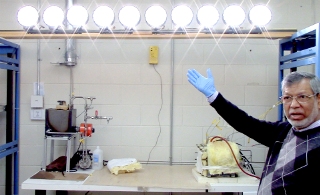May 5 2015
Trenergi, a Hopkinton, MA-based fuel cell developer, recently demonstrated its breakthrough 1–kilowatt (kW) fuel cell prototype to a group of investors. The fuel cell, based on a radically different design than existing fuel cells, is capable of efficiently and cleanly generating on-site electricity, heat and hot water from most existing fuels.
 Dr. Mohammad Enayetullah, a pioneer in fuel cell technology, demonstrates Trenergi’s one kilowatt fuel cell for a group of investors. (Photo: Business Wire)
Dr. Mohammad Enayetullah, a pioneer in fuel cell technology, demonstrates Trenergi’s one kilowatt fuel cell for a group of investors. (Photo: Business Wire)
“Our fuel cell represents a dramatic leap forward in the existing technology,” said Norman F. Strate, Chairman and CEO. “It achieves incomparable levels of efficiency and has the advantage of being able to operate on almost all available hydrocarbons. Our fuel cell represents the bridge to a cleaner and more secure energy future.”
Trenergi utilizes a patented High-Temperature Proton Exchange Membrane-Plus (HTPEM+) design. This design marks a major advancement over previous HTPEM designs that utilized BASF material for the membrane. The company’s Chief Technology Officer, Dr. Mohammad Enayetullah, who has authored or co-authored more than 10 fuel cell patents, has achieved a major advancement in the membrane/electrode technology, which allows for higher power density and lower manufacturing cost than previously achievable, and has greater impurity tolerance, allowing the fuel cell to operate using readily available fuels, such as propane, natural gas, and even jet fuel, instead of the pure hydrogen required by older fuel cell technologies.
Trenergi also has developed a 3kW fuel cell prototype, which has been sold to a major defense contractor for testing as part of distributed energy systems or in mobile defense applications.
As Trenergi’s system operates at high temperatures, it is able to generate not only electricity but heat and hot water. As a result, it is able to operate at up to 90 percent energy efficiency. Trenergi’s fuel cell saves as much as 44 percent in energy usage compared to grid-sourced electricity for power and natural gas for hot water. It reduces climate change emissions by more than 60 percent compared to the average US coal plant and as much as 45 percent compared to the average US natural gas power plant. The system is also three-times more durable than competitor solid oxide and low-temperature PEM fuel cells.
The 1kW unit could produce 24 kWh/day of electricity – equivalent to about 80 percent of the average U.S. household’s electricity consumption – and approximately 160 gallons of hot water a day at a cost savings of approximately 44 percent. Trenergi anticipates constructing fuel cells of up to 100 kW in power.
These fuel cells could operate alone or as part of a microgrid and provide electricity, heat and hot water for an almost limitless range of residential, commercial, emission-reduction, and defense applications both in the developed and developing world.
"Trenergi expects to build next generation, higher power density demonstration units and have reference designs for manufacture by local strategic partners," said Strate.